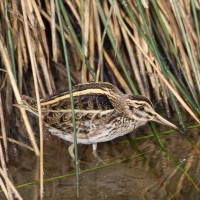Beschrijving
The area around Horn kyrka is a quite good site for geese with hundreds of Taigarietgans, Grauwe Gans, and Grote Canadese Gans found most years. Often with lesser amounts of Kolgans, Toendrarietgans, Kleine Rietgans, and Brandgans interspersed. Rotgans has been seen. Most geese are found by Rien (marked with a star on the map) in late Febuary and March.
During the spring Riens water overflow and large amounts of open water form. When this happens large amounts of Wilde Eend (at most 200), and Wintertaling (at most 150) rest in the area. Among these ducks you can observe smaller amounts of Smient, Krakeend, Smient, Pijlstaart (uncommon), Slobeend (uncommon), and Zomertaling (rare). Sometimes also some diving ducks. But since water levels vary each spring the amount and variation of ducks at Rien vary accordingly. The wetland at Hornebergs holds permanent water, and usually some dabbling ducks, but not in the same amount. Horn Marsh along with its ponds is also quite good for small amounts of different dabbling ducks.
Diving ducks are most usually found in Åsunden with Grote Zaagbek, Kuifeend, Brilduiker being common, while Middelste Zaagbek and Nonnetje are uncommon. At Trossbonäs rare diving ducks like Zwarte Zee-eend, and Grote Zee-eend can be found with luck in April. Even Eider and Topper have been seen there.
In spring if Rien has water in late April waders rest there. Bosruiter, Witgat (at most 23), Kievit, and Watersnip (at most 100). On the fields Goudplevier, at Åsunden Oeverloper sing, and in the forests Houtsnip can be found. During heavy autumn rain Rien can gain enough water for waders such as Groenpootruiter, Kemphaan, Bonte Strandloper, Wulp, Bontbekplevier, and Krombekstrandloper. The fields around Bränna and Västa eneby are pretty good areas for Bokje in November.
Among predatory birds Torenvalk, Buizerd, Wespendief, Ruigpootbuizerd, Zeearend, Sperwer, Havik, Visarend, Boomvalk and Blauwe Kiekendief are all common. Steenarend, Smelleken, Slechtvalk, and Zwarte Wouw are all rare but seen some years. The best places for them are Bränna, Rien, and Åshorva.
Large amounts of passerine birds move along the fields around Horn, therefore large amounts of Kneu, Graspieper, Gele Kwikstaart and other common meadows birds are found along with other rare passerine birds like Blauwborst, Beflijster, IJsgors (very rare), Sneeuwgors, and Frater. The best places for these are Bränna and Rien.
The wetland around Rien and Hornsberg have large amounts of reed and trees which make them excellent places for nightactive birds. All the common bird are found some years with Kwartelkoning, Kwartel, Struikrietzanger, Krekelzanger, Porseleinhoen, and Sprinkhaanzanger. Even Klein Waterhoen has been found.
Details
Toegang
Horn is located on the southern shores of lake Åsunden. No good parking spots can be found for most of these places but it is often possible to park alongside the road. The area is best explored with bike or car and perhaps not best suited to tourists because there are few facilities for visitors.





